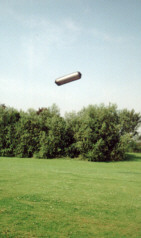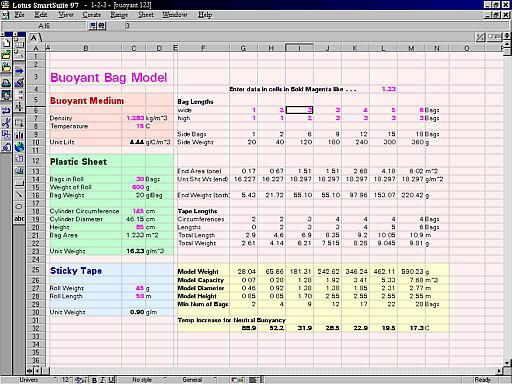Make Your Own Solar-Powered UFO
| Download | Install | UFOs - You decide | They're Here :-) | Build Your Own |
|---|
There are essentially two ways of doing this, the Easy Way and the Not So Easy Way but before that . . .
Safety First. DO NOT FLY kites, balloons or anything else with a tethering string, such as this, near to any overhead power cables. To be safe, make sure that the length of line is FAR SHORTER than the distance to the nearest power cable in any direction. This type of buoyant device is best flown in still air which can have slight, short-lived or even prolonged gusts in ANY DIRECTION so BE SAFE. I have found it best to fly away from trees, houses and other structures that the cord can snag against.
The Easy Way
is  to
to  purchase the Solar Powered Air Ship
from Astromedia
at http://www.astromedia.de/.
These are not expensive, they are quick and easy to put
together, all of the maths is done, all of the materials
are sourced and packaged for you in the correct amounts
from one supplier, they only cost a few German Marks or
Euros, you can order them over the Internet and all you
have to do is to follow the instructions. No sticking or
cutting - if you can tie knots in string, you can make
this.
purchase the Solar Powered Air Ship
from Astromedia
at http://www.astromedia.de/.
These are not expensive, they are quick and easy to put
together, all of the maths is done, all of the materials
are sourced and packaged for you in the correct amounts
from one supplier, they only cost a few German Marks or
Euros, you can order them over the Internet and all you
have to do is to follow the instructions. No sticking or
cutting - if you can tie knots in string, you can make
this.
I would recommend that you start with one of these (as I did) so as to get the hang of what is going on - how to handle it, wind conditions and so on. These are quite impressive and you occasionally hear people expressing astonishment. On the left, you can see one about 40 metres up in the air and on the right, one fairly close to the ground. They are around 2.5 metres or so long and you can see the shadow on the ground on the right (it is quite close to the trees). They move quite slowly and people generally don't notice them until you draw attention to them (try pointing into the air and people will look where you are pointing. Just for a joke, try standing still in a street, with a friend and point at some part of the sky - you will soon find that others will stop and try to see what you appear to be looking at and very occassionally, someone else will point and if you are really lucky, you may even get someone to claim to someone else that they can see something). These balloons will go very high and on one occassion we even had birds circling it.
 The
Not So Easy Way is this . . .
The
Not So Easy Way is this . . .
Note: Since writing this page around 20 years ago, I have written an online calculator that you can access here. That way, you won't need to download a spreadsheet, you can do it all on your smartphone.
This is for a very simple cylinder (right) made from bin liners from a supermarket. It has the advantage that you can make it any shape or size you want within the laws of physics (as we know them ;-). Make it like the animation on the right or make it slightly flatter and more like a UFO. All you need to do is unroll, cut and tape. This page shows you how.
You need:
- A set of scales that can weigh from a few grammes to around 600 grammes (this bit stays in your kitchen :-);
- A role of Thin Black Plastic Bin Liners (you know, the sort that you put rubbish in and the plastic is so thin that it falls straight through the bottom - remember that all you want to do is hold hot air);
- A new role of Sticky Tape (Sellotape or similar is good enough, again, you are holding plastc bags together to stop air escaping so you don't need anything heavy duty); and,
- Cord (ideally, around 500 feet of kite flying cord is best. Don't use fishing line monofilament as this will snag. Don't go any longer than the kite flying regulations will allow for where in the world you are. Choose the lightest and strongest cord you can get hold of, remember that you need to be able to control it).
If you can get
that lot together then you can start to calculate how you
should build one. To help, I have made a lotus 1-2-3 97
spreadsheet that you can download (screen shot on the
right in 1024 x 768 mode) and it will do all of the hard
work for you (calculating which variants are more likely
to fly than others). This is what you do . . .
can get
that lot together then you can start to calculate how you
should build one. To help, I have made a lotus 1-2-3 97
spreadsheet that you can download (screen shot on the
right in 1024 x 768 mode) and it will do all of the hard
work for you (calculating which variants are more likely
to fly than others). This is what you do . . .
- Weigh the role of Bin Liners (I got 600g). Knowing the number of liners (mine had 30 on it) lets you calculate the weight of one.
- Take one of the liners off the role and cut across the bottom to make an open-ended tube. Measure the height (from open end edge to open end edge, I got 85cm) and the circumference (twice the width, I got 145cm). This will give you the area and allow you to calculate the unit weight of the plastic (grammes per square metre).
- Weigh a complete roll of sticky tape (ignore or guess the core weight as the useage and the errors elsewhere will make it irrelevent unless it is made from cast iron, I got 50g so I used 45g). Being a complete roll, you should know its length (mine was 50m) so now you can calculate its unit weight (grammes per metre).
- Take it from me that air weighs around 1.283 kilogrammes per cubic metre, the air temperature was around 15C and raising one cubic metre of it by one Celius will provide roughly 4.4 grammes of lift (I included this so that you can use this if you live at high altitude so you can change the density).
So much for the column on the left, now, you can calculate the number of degrees centigrade elevated internal temperature required to make the UFO weigh the same as the air that it is in. Any hotter and it takes off (hopefully providing enough lift for the length of string that you have, hence choose a lightweight string). You can see that the spreadsheet makes life easier as it will calculate the required temperature elevation that your black bin liner will need to generate from the amount of solar radiation falling on its surface for a given configuration of bin liners. To generate output from the model, all you need to do is to put in the number of bin liners that you put side by side and end to end. Try putting a thermometer inside a black bin liner and measuring the increase in temperature that it will generate for where in the world you are when the sun shines on it.
Wide. If you use your bin liner tube without slitting it up the side, you will not have to tape up the side (the model takes this into account by having one less length of tape in that case) but if you do slit the liner up the side, you can stick 2, 3 or more, side by side to make a larger diameter cylinder (less surface area for a given volume). This is the number in the "Wide" row.
High. If you tape the open ended bin liner cylinders end to end, you can increase the enclosed volume. This number is put into the "High" row.
This is where to put the figures on the spreadsheet (only in the Bold Magenta Cells) . . .
| Buoyant Bag Model | Enter data in cells in Bold Magenta like . . . | 1.23 | |||||
| Buoyant Medium | Bag Lengths | Example 1 | Example 2 | ||||
| Density | 1.283 | kg/m^3 | Wide | 3 | 5 | Bags | |
| Temperature | 15 | C | High | 2 | 3 | Bags | |
| Unit Lift | 4.44 | g/C/m^3 | Side Bags | 6 | 15 | Bags | |
| Side Weight | 120 | 300 | g | ||||
| Plastic Sheet | End Area (one) | 1.51 | 4.18 | m^2 | |||
| Bags in Roll | 30 | Bags | Unit Sheet Weight (end) | 18.297 | 18.297 | g/m^2 | |
| Weight of Roll | 600 | g | End Weight (Both) | 55.10 | 153.07 | g | |
| Bag weight | 20 | g/Bag | |||||
| Cylinder Circumference | 145 | cm | Tape Lengths | ||||
| Cylinder Diameter | 46.15 | cm | Circumferences | 3 | 4 | Bags | |
| Height | 85 | cm | Lengths | 3 | 5 | Bags | |
| Bag Area | 1.233 | m^2 | Total Length | 6.9 | 10.05 | m | |
| Unit Weight | 16.23 | g/m^2 | Total Weight | 6.21 | 9.045 | g | |
| Sticky Tape | Model Weight | 181.31 | 462.11 | g | |||
| Roll Weight | 45 | g | Model Capacity | 1.28 | 5.33 | m^3 | |
| Roll Length | 50 | m | Model Diameter | 1.38 | 2.31 | m | |
| Unit Weight | 0.90 | g/m | Model Height | 1.70 | 2.55 | m | |
| Minimum Number of Bags | 9 | 22 | Bags | ||||
| Tempreature Increase required for Neutral Buoyancy | |||||||
| 31.9 | 19.5 | C | |||||
This is all about enclosing the largest volume with the smallest surface area so the more "spherical" the shape, the better it will perform, ie. the smaller the required temperature difference for a given lift.
Of course, there is nothing to stop you from making the shape a little more like a flattened truncated cone or from putting partially transparent sections on it (using white swing bin liners) or using different coloured bin liner pieces to make colourful characters or emblems as long at it remains tethered securely.
Some things to consider are:
- Tape will stick to the other (in)side if you don't make sure that the joints in the plastic sheet are edge to edge;
- You should make sure that your tether string is secure as it will just float away if it breaks free (remember it will have your finger prints and DNA all over it so there is no denying things if it ends up causing an accident - it doesn't have to be sucked into an aeroplane engine to cause an accident, remember that what goes up eventually comes down and if it goes across a road, it could cause a serious road accident so be careful);
- A colder outside will give a better lift for a given temperature rise (greater density);
- The amount (length) of string that a given balloon will lift will be limited by the density of the air where the balloon is (ie, higher up, there is less lift as well as more weight of string);
- The higher the temperature, the lower the intial density;
- The higher up you are to start with (mountain regions) the lower the air density and therefore the lower the lift (you can find data like this in physics books);
- The larger balloons will take longer to warm up;
- The skin of the balloon will allow heat to flow out of it by conduction (you can see a heat haze around the outside of the balloon; and,
- The Minimum Number of Bags is calculated from the bags used in the side and the area required to cover the ends. It may well take one or two more bags.
Have Fun
File size 14,688 Bytes
MD5
hash = 84e187e818af1a57ce4bcb640db4cec8
Click here to see how to link to this site
| Download | Install | UFOs - You decide | They're Here :-) | Build Your Own |
|---|